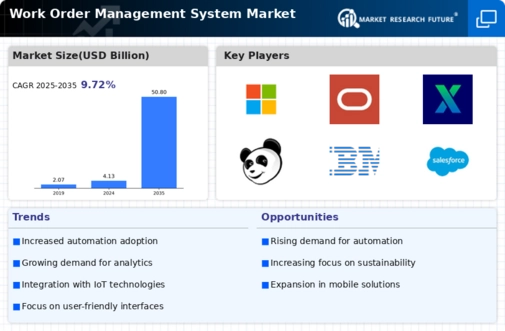Rising Adoption of Mobile Solutions
The Work Order Management System Market is also experiencing a notable rise in the adoption of mobile solutions. With the increasing prevalence of mobile devices, organizations are seeking to empower their workforce with mobile access to work order management systems. This shift enables field technicians to receive real-time updates, manage tasks, and communicate effectively while on the go. Recent statistics indicate that mobile-enabled work order management systems can enhance response times by up to 25%. As businesses prioritize mobility and flexibility, the demand for mobile-compatible work order management solutions is likely to expand, driving growth in the market.
Enhanced Customer Experience Expectations
The Work Order Management System Market is significantly influenced by enhanced customer experience expectations. Customers today demand timely and efficient service, which places pressure on organizations to optimize their work order processes. Companies that utilize effective work order management systems can improve service delivery, leading to higher customer satisfaction rates. Research indicates that organizations that prioritize customer experience see a 10% increase in customer retention. As businesses strive to meet these heightened expectations, the adoption of work order management systems that facilitate better communication and faster service resolution is likely to increase, further driving market growth.
Regulatory Compliance and Safety Standards
Regulatory compliance and adherence to safety standards are becoming increasingly critical in the Work Order Management System Market. Organizations are required to maintain compliance with various regulations, which necessitates the effective management of work orders related to safety inspections and maintenance activities. The implementation of work order management systems can facilitate compliance by providing a structured approach to tracking and documenting work performed. This is particularly relevant in sectors such as construction and utilities, where non-compliance can result in significant penalties. As the focus on regulatory compliance intensifies, the demand for work order management systems that support these requirements is expected to grow.
Increased Demand for Operational Efficiency
The Work Order Management System Market is experiencing a surge in demand for operational efficiency across various sectors. Organizations are increasingly recognizing the need to streamline their processes to reduce costs and enhance productivity. According to recent data, companies that implement effective work order management systems can achieve up to a 30% reduction in operational costs. This trend is particularly evident in industries such as manufacturing and facilities management, where the ability to manage work orders efficiently can lead to significant improvements in service delivery and resource allocation. As businesses strive to remain competitive, the adoption of work order management systems is likely to continue to rise, driven by the need for enhanced operational performance.
Growing Emphasis on Data-Driven Decision Making
In the current landscape, the Work Order Management System Market is witnessing a growing emphasis on data-driven decision making. Organizations are increasingly leveraging data analytics to optimize their work order processes, leading to improved outcomes. The integration of analytics within work order management systems allows businesses to track performance metrics, identify bottlenecks, and make informed decisions. This trend is supported by the fact that companies utilizing data analytics in their operations report a 20% increase in efficiency. As the importance of data continues to rise, the demand for sophisticated work order management systems that facilitate data analysis is expected to grow, further propelling the market.


















Leave a Comment